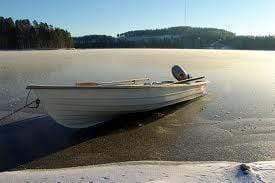With the first chill of fall, anglers everywhere know that the harsh winter months are fast approaching. Winterizing your boat is a necessary step towards keeping your investment in top shape. By following these simple practices you can ensure that your boat will start without a hitch in the spring, allowing more time on the water and less time at the boat repair shop.
Cleaning
A thorough cleaning of your boat and trailer is a good start in the winterizing process. Remove all items from the boat, including life jackets, fishing equipment, electronics and seats. It is better to keep these items inside during the winter months so as not to expose them to the elements.
Now that you have an empty boat, it may be a good time to apply a coat of wax on the hull and vacuum the interior. Fully inspect all hatches for dirt and water, and leave them open overnight to air dry. Next, remove the batteries from the boat. Clean the terminals with a wire brush and a baking soda and water mixture, and then apply some petroleum jelly or grease to the terminals once they're dry. Check water levels and fill up if necessary. The battery should be fully charged and charged periodically throughout the winter months to keep it topped off and in good shape.
Winterizing the Engine
This is perhaps the most important process of winterizing a boat. First, fill up all gas tanks to ensure that moisture won’t build up over the winter months. Using a product like the T-H Marine Winter-Eze™ Sterndrive Winterize Systemwill make the winterizing process much simpler. To winterize your boat with this system, simply follow these steps:
(1) Slip the unit onto the stern drive over the intake manifolds.
(2) Attach the tubing to the cooling exhaust holes.
(3) Use a garden hose to supply fresh water to the reservoir.
(4) Start your engine.
(5) Let the engine run to flush out dirty water and open the thermostat.
(6) Place the tube ends in the reservoir to allow recirculation.
(7) Add antifreeze to the reservoir until a safe level of antifreeze and water is obtained.
(8) Turn off engine and remove the winterizer.
Inspection
Even though a boat should be inspected each time before it is put in the water, this is a great opportunity to do a full inspection of the whole boat. Make a detailed checklist and keep it with you throughout the process. This is also a good time to make a complete inventory of all accessories.
Cover
If you are storing your rig outdoors, there is no over-doing this step. Water, leaves and pests can all find their way in even the smallest hole in a cover, so make sure to have a cover that is the right size for your boat. Start with your regular boat cover, pulling it tight and using multiple ropes and bungee cords to secure it to the boat. It should fit snugly over the top now that all of your extra equipment has been removed from the inside of the boat. For extra protection, place several layers of poly sheets and tie these down securely as well.
As you can see, winterizing a boat is not a difficult task and can be completed by one person in one afternoon. By following these simple steps, you can make sure that your boat will be safe and ready the next time it is taken out - after all, spring is right around the corner!







